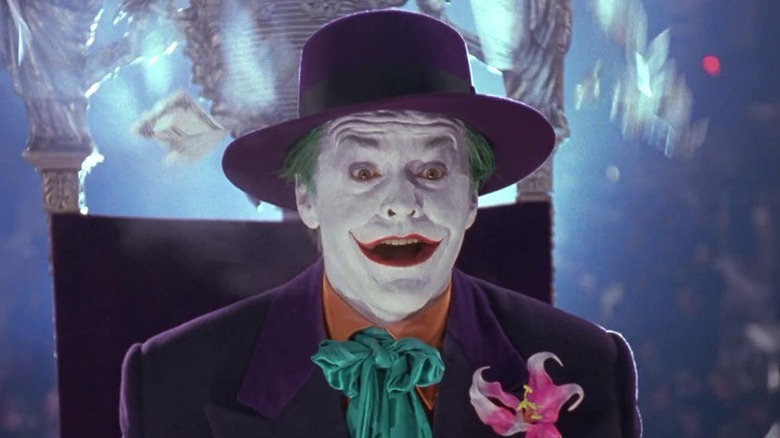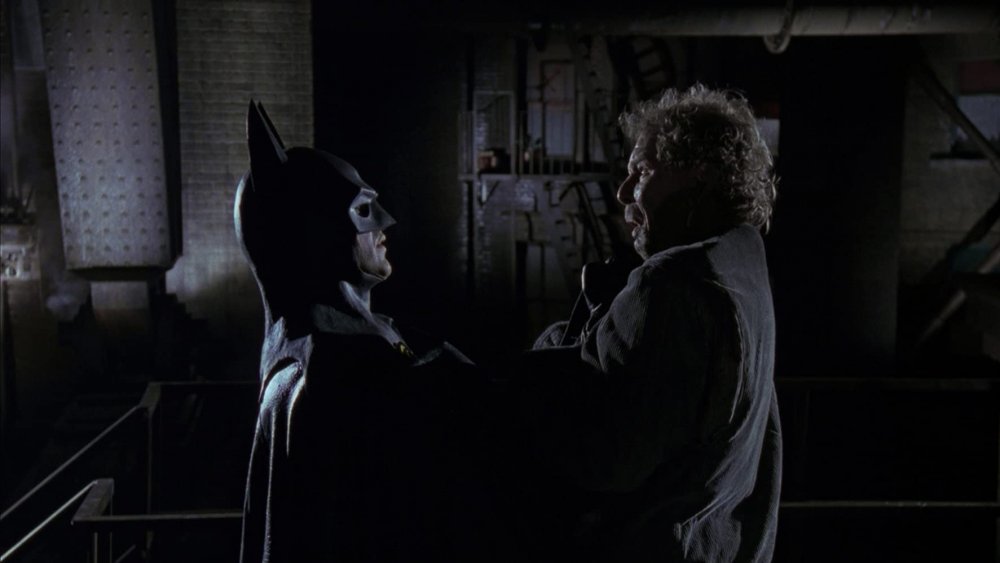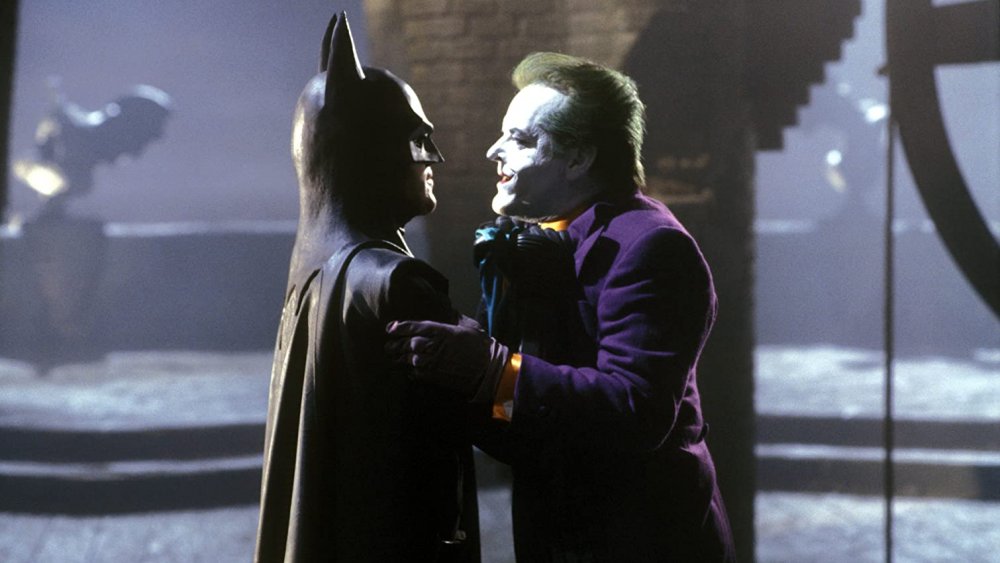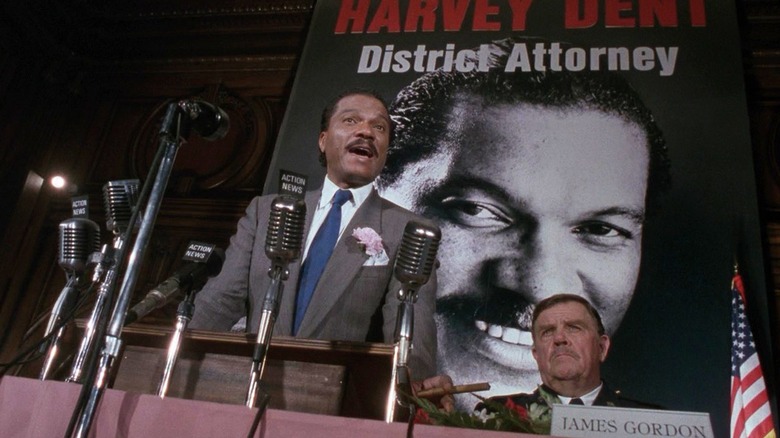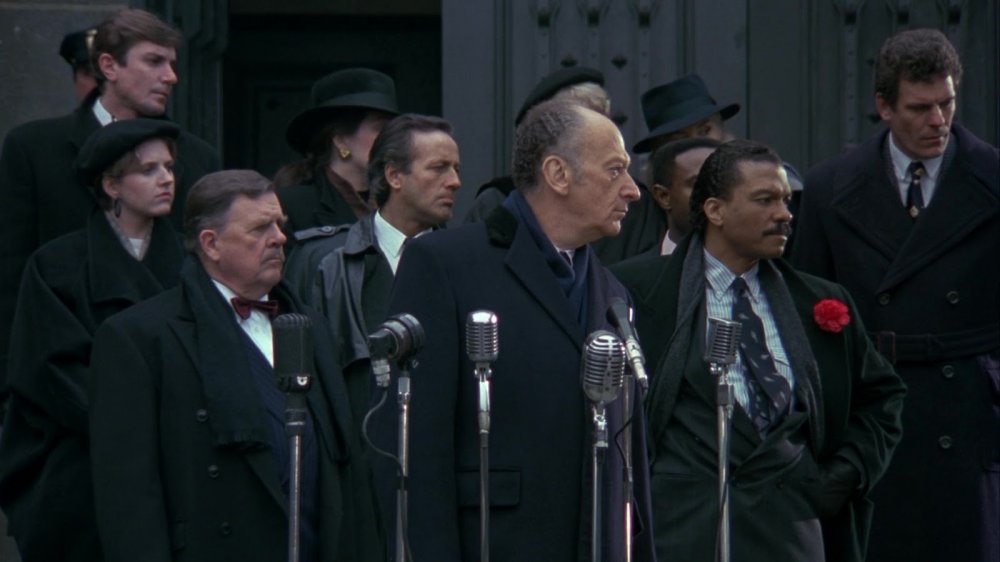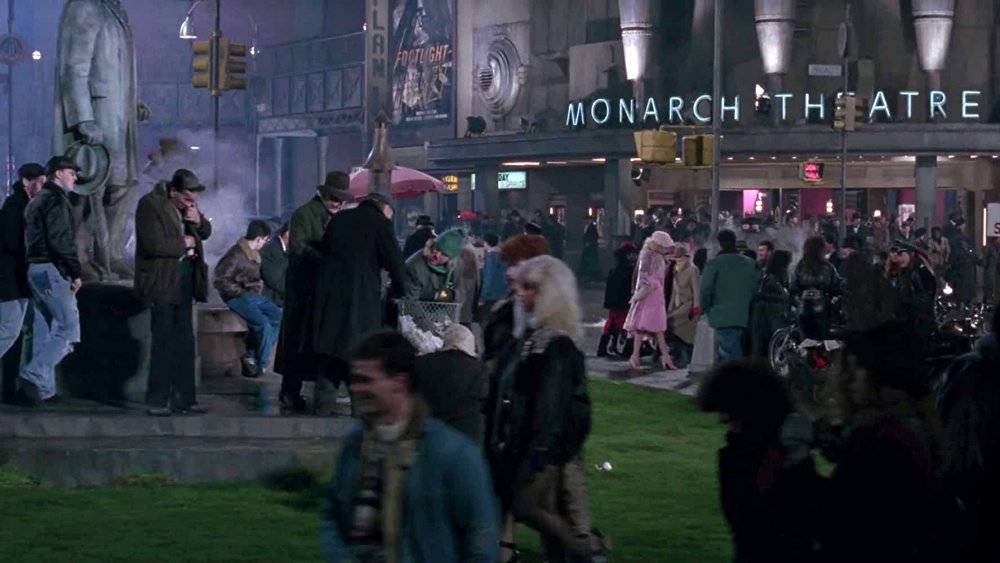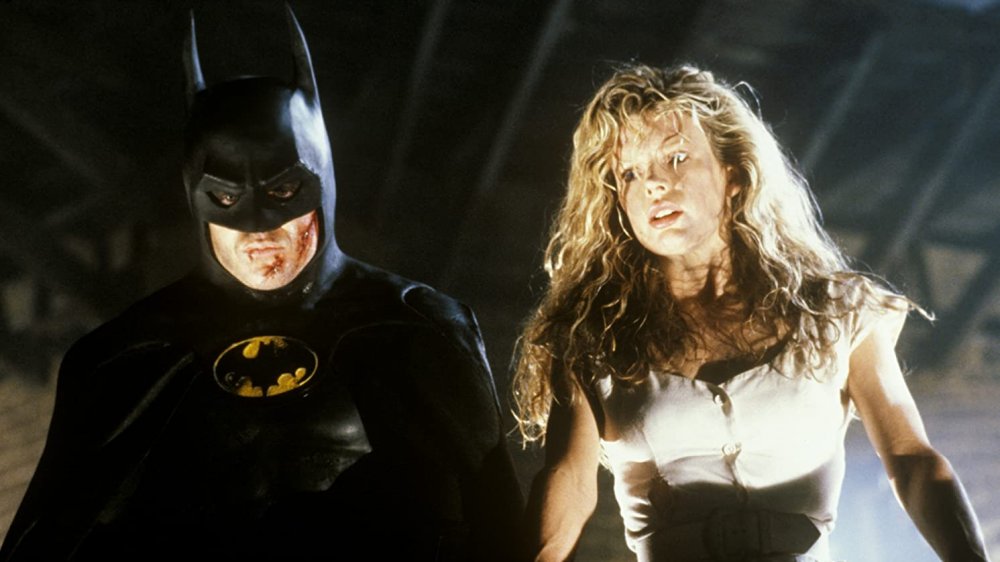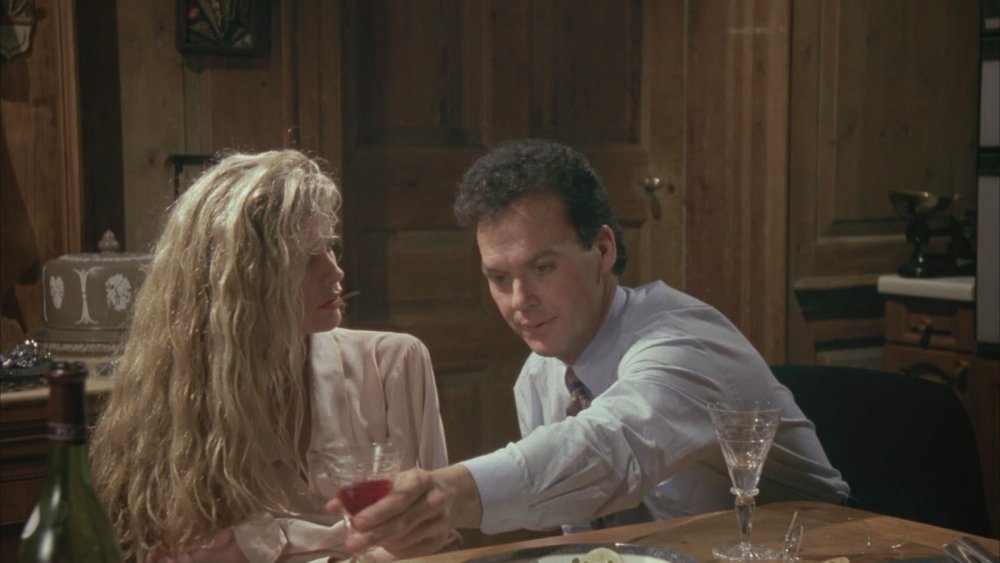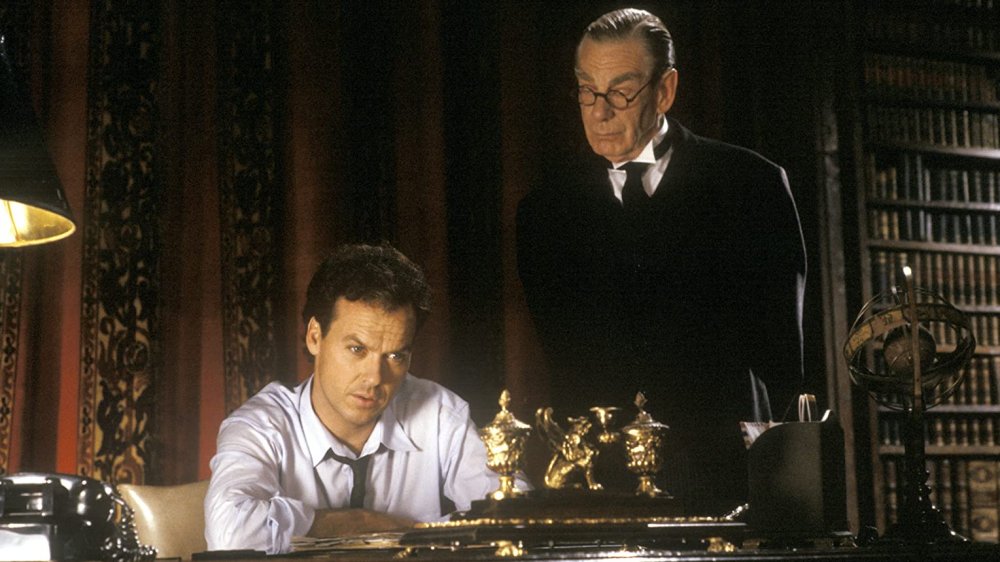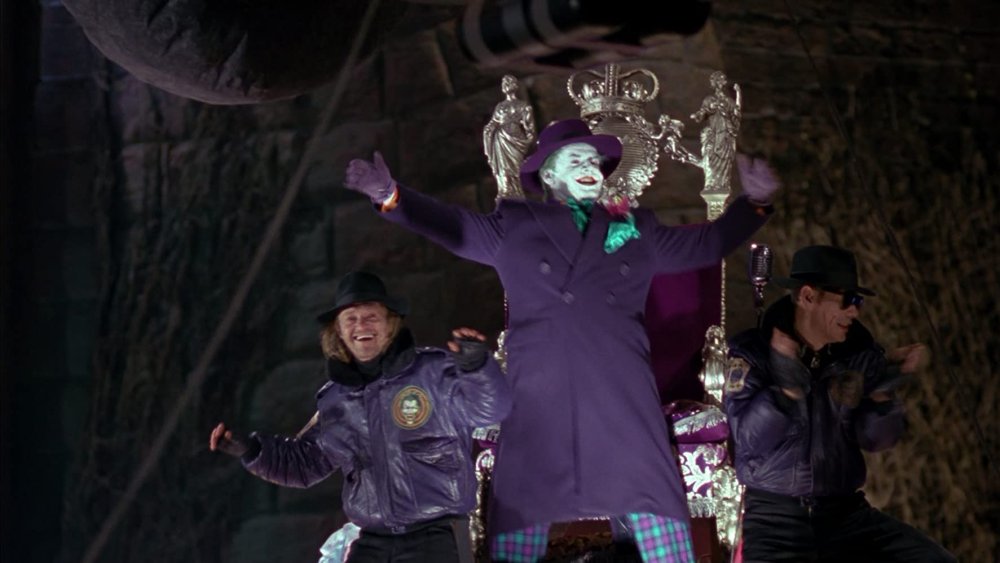Things Only Adults Notice In 1989's Batman
In 1989, the superhero movie landscape changed forever when Warner Bros. released Batman, the first modern blockbuster incarnation of the Caped Crusader on the big screen. While Batman's previous live-action incarnations had embraced the camp of the 1960s, director Tim Burton sought to embrace the "dark" in Dark Knight, giving us a shadowy, art deco Gotham City, a Batman clad in almost all black, and a very murderous incarnation of the Joker.
Looking back at Batman now, it's clear that it's a film marketed to adults who wanted a more grown-up superhero experience, but that didn't stop kids from watching it. The film was a childhood staple for a generation of children in the 1990s, many of whom are still showing it to their kids today. That, of course, means there are still plenty of things in this film that go over the kids' heads while the adults see a bigger picture. These are things only adults notice in Batman.
Batman the beginner
Though it doesn't try and give us the full origin story treatment for the character, there are many clues in Batman which suggest the Dark Knight hasn't been on the job for very long. With the exception of reporter Alexander Knox, the Gotham media thinks he's a myth, if the cops know he's real, they're not telling anyone, and even the criminals on Gotham City's street are convinced that their friends who say they saw him are either high or crazy. Batman's word of mouth game has not yet spread, in part because it seems he's still perfecting his crimefighting game.
When you're a kid watching this movie, everything Batman does is cool, whether he's ziplining through a museum or driving the Batmobile through Gotham's streets. As an adult, though, you notice certain things he does which indicate that he's still getting the hang of it all. One key example comes right at the beginning of the film, when Batman takes down some crooks after a mugging. An overhead shot shows that he's clearly watching the mugging from a Gotham rooftop, but rather than intervening and stopping the crime before it happens, he's content to hang back and deal with the criminals later. Maybe he's just biding his time before revealing himself, but he does tell the criminals to "tell your friends about me," so maybe he's just not sure exactly what he's doing yet.
Batman and mortality
Batman fans like to argue, and one thing they've been continually arguing over for decades is whether or not the Caped Crusader should be comfortable with killing people. For some fans, it's an absolute no-no tied to Bruce Wayne's own trauma: Death made him, and he'd like to make sure it doesn't happen to other people. For others, it all comes down to what has to be done; sometimes that means killing, and sometimes that means passively letting someone die. For the version of Batman in this movie, it's... both, kind of?
Over the course of the film, as Batman takes on all manner of bad guys from petty thieves to the Joker himself, he seems to switching back and forth between minimizing damage and just flat-out murdering dudes. In the Axis Chemicals fight early in the film, he goes out of his way to string up a gangster by his ankle so the cops can arrest him, but by the end of the movie he's unloading machine guns and missiles from his jet on a city street to kill the Joker Gang as quickly as possible. Then there's the way he treats Joker himself, first trying to save Jack Napier from the chemical vat, then dooming him to die at the end of the movie. Crimefighting is complicated, and Batman is clearly still figuring out what to do with the lives he's taking into his vigilante hands.
Gotham law enforcement strategy
Batman's not the only major player working to combat Gotham City's crime, of course. The 1989 film also introduces its own versions of major supporting characters like Commissioner Gordon and District Attorney Harvey Dent, and it's established very early on that they've got their work cut out for them. Gotham City is, as the film shows and tells us, overrun with crime, and much of the city is in the pocket of gangsters, including some of the cops. Dent's job as the newly elected DA is to clean up all that crime and corruption, and he seems to have the charisma and the determination to do it.
What Dent seems to have less of, though, is a sense of strategy. At a banquet for Gotham's elite, he proclaims his intention to raid various crime family hotspots within the next week. The problem? The event is being broadcast live on local television, so the crime bosses see him announcing his plans even before he's carried them out. Within hours, the Gotham underworld is mobilizing to hide evidence, and even having strategy meetings of their own. If you want to take down high-powered criminals, not telling them when you're coming might be a good start to your plan.
Gotham's careless mayor
One of the things Batman does very well from the beginning is establish that its heightened, often unhinged version of Gotham City is a place that needs someone like Batman looking out for it. If you're a kid watching the film, just looking at Gotham is enough to make you realize it's the kind of place the Caped Crusader should be running around in , but if you're an adult you might need more convincing, which is why the film is full of people who just don't seem to be able to rise the occasion. Gotham's mayor is one of those people.
Mayor Borg appears in several scenes throughout the film, and in almost all of them he seems to really only have one priority: Put on the planned 200th birthday festival for the city that's been in the works for months. Yes, he talks about controlling crime and arresting mob bosses in front of cameras, but whenever he talks to his District Attorney and his Police Commissioner, it all ties back not to public safety, but to his beloved festival. He finally relents when the Joker's rampage gets too out of control, but only after spending most of the movie pushing the festival at all costs. The implication is clear: This is a mayor who doesn't think he can get re-elected unless he's perceived as a winner who can throw a great party, and the safety of his citizens clearly matters less than that.
Gotham's income inequality
Everything about the version of Gotham City in Batman is heightened, in part because that's just how Tim Burton movies work, but also because the film is trying to show its viewers a strange world that can accommodate an equally strange character like Batman. So we get a bright Gotham 200 banner going up above almost cartoonishly dark old statues. We get an abandoned church with a creepy bell tower in the middle of the city. We get streets that seem to pump steam and smog out of every crevice. And, of course, we get rampant wealth inequality.
The film's characters are constantly talking about how bad the state of Gotham City is. They tell us crime is on the rise, people are terrified, and the regular citizens of the city don't know who to turn to. It's all a shorthand for letting us know that this is a place that needs Batman, but adults watching the film will also know that a lot of rich people in Gotham City just don't care. Yes, some of them turn out for a charity gala at Bruce Wayne's house to presumably do some good, but others just happily seem to go about their lives. When Vicki Vale walks into the Flugenheim Museum, she finds it packed with people in fur coats, oblivious to the troubles of the city, enjoying the benefits of wealth. Gotham has a one percent, and many of them don't seem to care who's in charge.
Vicki's thing for bats
Though Batman is the star of the movie, much of the exposition in Batman comes through the characters of reporter Alexander Knox and photojournalist Vicki Vale, who take it upon themselves to investigate Batman, who he is, and where he came from. The film spends a lot of time with these two characters as they get closer to the truth, and as Vale herself gets closer to Bruce Wayne, and in that time we get to learn a few things about them. One of which is, of course, that Vicki Vale is just super into bats.
Knox is investigating Batman because it's his job. He lives and works in Gotham, but Vale is a newcomer to the city who just shows up at Knox's desk offering to work with him. She's an acclaimed photojournalist and fashion photographer, and when Knox asks her why she's suddenly so interested in a case that even his coworkers think is bogus, she replies: "I like... bats."
Now, the kids in the room might hear that and go "Yeah, I like bats too, because they're cool," but the way Kim Basinger delivers the line suggests to the grown-ups that something else is going on. Vicki Vale came to Gotham City, in part, because she heard there was a man in a bat costume running around and thought "I need to get closer to that," and we're guessing her motives were more than journalistic.
How famous is Bruce Wayne?
Batman establishes through a number of contextual clues that the title character is a relatively new figure in Gotham City, therefore some people aren't even sure he's real. The same can't be said of billionaire Bruce Wayne, who the film establishes is both a lifelong resident of Gotham and someone who can fill up his mansion with distinguished guests for a benefit. What the film is less clear about is exactly how famous Bruce Wayne is, despite his billionaire status.
Vicki Vale and Alexander Knox, two professional journalists, go to Wayne Manor for his benefit without having a clue what he actually looks like, which suggests that he either keeps to himself or they just didn't do their research. Later, Vale actually tries to research Wayne more, but finds the file the newspaper keeps on him to be a little light. Still later, Knox goes through the microfiche collection and finds a series of headlines explaining the murder of Bruce Wayne's parents and his subsequent life as an orphan. It's played like a big secret, but wouldn't any Gotham reporter worth their salt know about arguably the most famous crime in the town's history, the one in which its richest citizens were gunned down? Either Bruce Wayne has actively tried to bury his own backstory, or Vicki and Alexander are just slacking.
Alfred's attention to detail
Batman wouldn't be complete without the presence of Bruce Wayne's trusted butler, friend, and confidante, Alfred Pennyworth. This version of Alfred, played with wit and charm by Michael Gough, is a classic butler character with an almost superhuman devotion to his job. He runs the massive Wayne household almost singlehandedly, points out details even Batman might miss, and is somehow able to juggle both his job as a butler and his personal duty as Bruce's emotional caretaker. In short: Alfred is a guy who doesn't miss much.
It's curious, then, that when Vicki Vale goes to Wayne Manor for a dinner date, the room in which she and Bruce are supposed to dine looks like a date hasn't really been prepared. The two sit at opposite ends of the super-long table, the candles in the room aren't lit for romantic ambience, and even the menu seems boring and bland. It doesn't take long for both Bruce and Vicki to decide to move to a more intimate environment, where Alfred himself is able to help win Vicki over through conversation at the kitchen table. Now, the kids in the room might not notice those details in the dining room, but as an adult it's hard not to think that Alfred might have planned those omissions, as a way to help his boss loosen up a bit out of necessity.
The Joker: Branding master
While the title character doesn't get a full origin story in Burton's film, Batman does devote some time to showing us how the Joker came to be. We get to see Jack Napier as the quick-witted, devious gangster beforehand, get to watch him fall into acid, and even get the story behind his horrific rictus grin. The film doesn't give us an exact timeline, but from the point Joker falls into the acid to the point he becomes the top crime boss in all of Gotham City, a couple of weeks at most seem to have passed.
It's a meteoric rise, and it's made all the more impressive by the fact that Joker has done it not just with wit and brutality, but with a very clear eye toward marketing. In a very short period of time, he not only hatched a plan to take over the Grissom crime family, but also designed his horrible gag gadgets like poison flowers and killer hand buzzers, and he found time to make all of his gang members matching purple jackets. He's even got his own logo, which he stamps on the jackets, on his TV commercials, and on his vehicles. Either Joker got one hell of a design consultant on the phone as soon as he came out of the acid, or he's just really passionate about branding. Either way, it's impressive.
